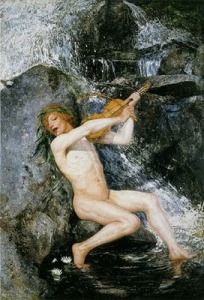The Midsummer celebration has a pagan background where the summer solstice was celebrated[1]. The summer solstice is when the sun is farthest away from the equator which makes that day the longest of the year. In the Northern Hemisphere the summer solstice occurs around June 21[2]. Before Christianity came to Sweden, the time of Midsummer was associated with sacrificial feasts and during the long and light nights of the summer solstice people partied a lot. It was also said that anything could happen during this time of the year. For example, fairies danced over the mist covered meadows which reminded people about things that were beyond their own world, folklore said that you should stay away from the Watersprite (or Näcken as we call him in Sweden) and therefore stay away from lakes and rivers. Midsummer time was also a time when witches gathered to meet with the evil[3].
In the 1000 century, when Christianity came so Scandinavia and Sweden, the men of the church wanted to quiet down the pagan celebrations and take away their believes of fairies and the Waterspite. Instead the church tied the midsummer celebration with St. John the Baptist and even gave him his own holiday, which is June 24th[4]. The festivity around Midsummer never disappeared, however, and therefore the Feast of St. John is also associated with the summer solstice celebrations[5].
The reason why the church wanted to change the reason to celebrate to St. John the Baptist’s day came from a strategy to replace already existing festivities with Christian festivities. This strategy origin from when Christianity was first introduced in the Roman Empire. For example; we celebrate the birth of Jesus on December 25th because this was a day when people in the Roman Empire celebrated a feast, the Unconquered Sun’s birth. And therefore they just changed the reason of the festivity but had it on the same day[6]. Reasons why St. John the Baptist was chosen as a man to celebrate is found in the bible. The first explanation comes from the fact that John was six months older than Jesus. We can conclude this because when the angel Gabriel told Mary that she was pregnant it was written in Luke 1:26 that John’s mother Elisabeth was six months pregnant at the time. The second explanation comes from what John the Baptist himself wrote in John 3:30: “He must increase and I must decrease”. Why the church has made such a connection is because at the summer solstice the day is the longest and the night is the shortest. In addition, at the winter Solstice which occurs at Christmas, the day is the shortest and the night is the longest. Therefore we can also conclude that after Christmas the days are getting longer and longer until Midsummer and after Midsummer the days are getting shorter and shorter. So after the birth of Jesus the days are getting longer and therefore he is increasing and John the Baptist is decreasing because after his birth the days are getting shorter[7].
Midsummer used to be celebrated on John the Baptist’s day on June 24, but in 1953 it was change so it would fit in better in the work week. Therefore Midsummer is after 1953 always celebrated on a Friday which means that it could be celebrated between June 20 and June 26[8].
The tradition of raising a Maypole on Midsummer is believed to come from Germany, and that it came to Sweden in the 1300 or 1400. Some of the tradition of the old fertility rites from pagan times is still implemented in today’s midsummer celebration when we dance around the Maypole[9].
[2] http://www.credoreference.com.rpa.laguardia.edu:2048/entry.do?id=9767601 (OR: “Summer Solstice.” Holidays, Festivals, and Celebrations of the World Dictionary. Detroit: Omnigraphics, Inc., 2010. Credo Reference. Web. 12 November 2013.

